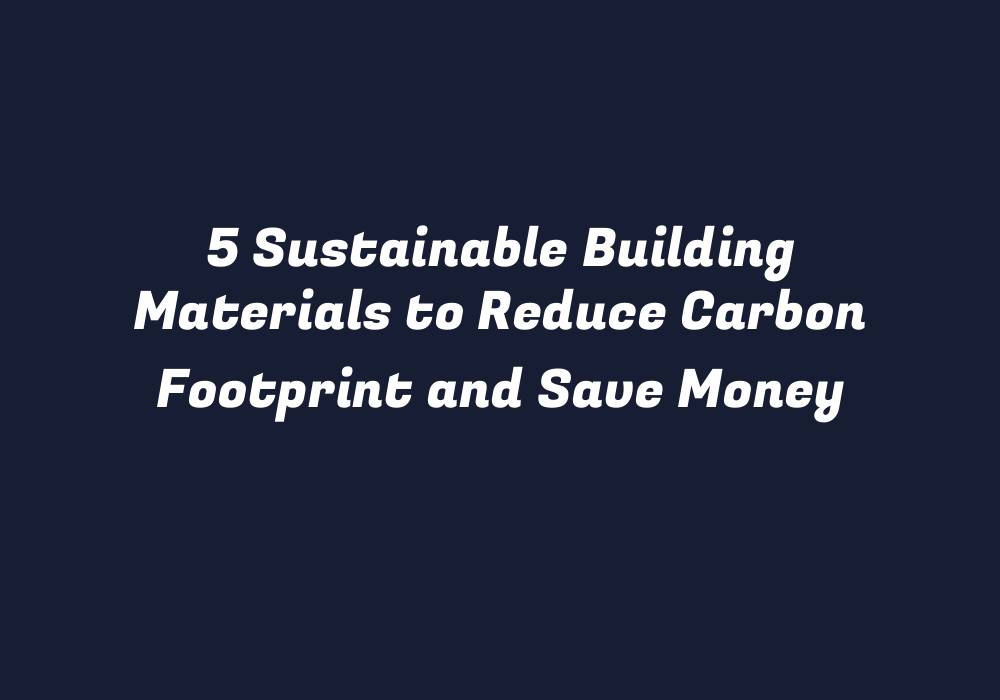Introduction: The Impact of Sustainable Building Materials on Reducing Carbon Footprint and Cutting Costs
In recent years, the global focus has shifted towards environmentally friendly practices as a means to curb carbon emissions and prevent climate change. Architectural innovations play a crucial role in this movement by incorporating sustainable building materials that minimize our carbon footprint while saving money on construction costs. This article delves into five such sustainable materials that contribute positively towards our environmental goals.
1. Bamboo: A Versatile and Renewable Option
Bamboo is a rapidly renewable material that can grow within just three to seven years, compared to the average timber tree growing cycle of 25-70 years. Its rapid growth rate makes it an ideal choice for building materials that help reduce deforestation and carbon emissions associated with conventional wood harvesting. Bamboo’s strength and flexibility allow for various applications, such as flooring, scaffolding, walls, furniture, and even structural elements in construction.
2. Hemp: A Sustainable Alternative to Conventional Textiles
Hemp is an environmentally friendly alternative to cotton, a water-intensive crop that requires large amounts of fertilizers and pesticides. The fiber produced from hemp can be used in textile applications like insulation panels and carpets. This material’s natural thermal properties help maintain the building’s internal temperature, reducing energy consumption for heating or cooling purposes.
3. Straw Bale Construction: A Cost-Effective and Eco-Friendly Method
Straw bales, primarily composed of wheat, barley, or rice stalks, are a sustainable alternative to concrete blocks and bricks in building construction. They offer excellent thermal insulation properties and contribute to energy efficiency, resulting in significant savings on heating and cooling costs. Moreover, straw bale homes are resilient against extreme weather conditions such as hurricanes and earthquakes, thanks to the bales’ interlocking nature that provides stability.
4. Rammed Earth: A Timeless and Durable Option
Rammed earth is a traditional building material created by compacting soil with small stones or gravel. This technique has been used for thousands of years due to its low embodied energy, natural durability, and thermal mass that can regulate indoor temperatures. Rammed earth walls are not only sustainable but also aesthetically pleasing, as they can be crafted into intricate patterns and textures.
5. Recycled Materials: Upcycling Waste into Building Blocks
Recycled materials play a crucial role in reducing waste production and energy consumption associated with the extraction of raw materials from their natural sources. The use of recycled plastic, glass, steel, or other waste materials in construction can create unique architectural elements while minimizing our carbon footprint. One example is the conversion of used plastic bottles into bricks for building walls and other structural components.
Conclusion: Sustainable Building Materials Benefit Society and the Environment
Incorporating sustainable building materials is a practical way to minimize carbon emissions, reduce costs associated with construction and maintenance, and support sustainable development. By embracing these eco-friendly alternatives, we can create innovative architectural designs that benefit society, the environment, and our overall future well-being.
Taking Action: Implement Sustainable Materials in Your Building Projects
Incorporating sustainable building materials into your next project is a proactive step towards minimizing our carbon footprint and promoting environmentally responsible practices. By working with eco-friendly construction methods, you can contribute to the global shift towards sustainability while saving money in the long run.
References
1. “Bamboo as a Sustainable Building Material for a Better World.” Global Bamboo Elite. https://globalbambooelite.com/bamboo-sustainable-building-material/.
2. “Hemp: The Ultimate Sustainable Alternative to Cotton.” TreeHugger. https://www.treehugger.com/hemp-ultimate-sustainable-alternative-cotton.html.
3. “Straw Bale Construction: A Sustainable Building Option for Energy Efficiency and Resilience.” EarthTalk.org. https://www.earthtalk.org/strawbaleconstruction/.
4. “Rammed Earth: The Ultimate Guide to Rammed Earth Walls, Benefits, Uses, and Applications.” EarthBuilding.co.uk. https://www.earthbuilding.co.uk/rammed-earth.
5. “Recycled Materials in Construction: Turning Waste into Opportunity.” Sustainable Home Design. https://sustainablehomedesign.org/recycled-materials-construction/.
